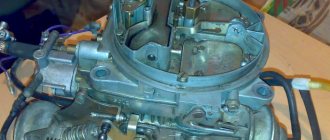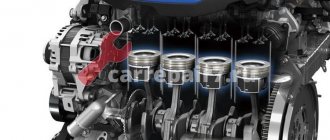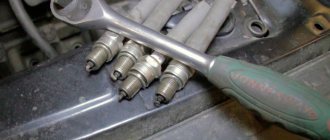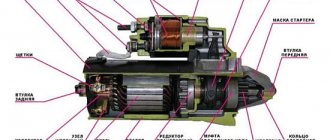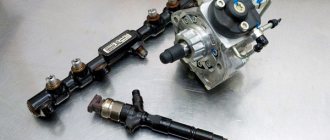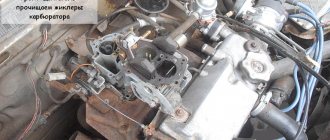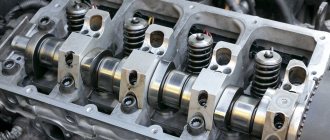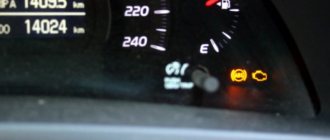It is useful for any fan of the domestic automobile industry to know the reasons why the Priora engine has 16 valves. After all, this problem is quite common. Ask any driver what the reason is, he will immediately give several options for the malfunction. And also ways to solve them. Of course, by interviewing many people you can find out all the reasons. But they still need to be checked. In addition, very often the cause of engine tripping can be several conditions at once.
To ensure that the problem is resolved, you need to check all possible options. Only in this case will you get rid of this problem.
Causes and Effects
The reasons why the Priora 16 valve engine is tripping can be very diverse. Several systems are involved in the normal operation of the engine. Therefore, to identify the source of the problem, it is necessary to check the following systems:
- Supply system;
- Ignition;
- Sensors
Very often, it is on Priors with a 16-valve engine that the problem arises due to power problems. Therefore, you need to check it first.
The consequences of engine tripping can be the most unpleasant. Outwardly, this manifests itself as hassle. After all, the engine is unstable and shaking. Often the interior begins to smell of gasoline. Don't forget the money issue. The car noticeably increases its appetite and you have to visit the gas station much more often. It's much worse that it leads to more serious damage.
First, the fuel settles on the cylinder walls and seeps into the block, mixing with the oil there. Due to this, the lubrication of the unit deteriorates, and parts wear out faster. It is also possible for a water hammer to form if a sufficient amount of fuel accumulates in the cylinder. In the simplest case, the remaining working cylinders bear a large load. As a result, their elements fail earlier. In any case, it is necessary to eliminate this problem in a timely manner.
Before you begin more specific troubleshooting, perform diagnostics using a laptop. This will help you determine which cylinder is not firing. Typically, such errors are recorded in the memory of the engine control unit. Having determined where the flash skip occurs, start working.
Causes of overclocking failure
You can determine the reason why the car jerks using diagnostics. Possible problems:
- Malfunction of the fuel supply system;
- Damage to engine temperature and mixture enrichment sensors;
- Errors in the ECU;
- Faulty spark plugs;
- Damage to high-voltage wires or ignition coils;
- Clogged or faulty injectors:
- Faulty HBO control unit;
- There is interference in the harness to which the fuel injectors are connected;
- Gas wiring;
- Bad mass.
Nutrition
A missed flash may occur due to the fact that there is simply nothing there to burn, that is, to flash. So first, start the engine. When it has been running for a couple of minutes, turn it off and remove the spark plug. If it turns out to be dry, then the reason is the lack of fuel. There may be several reasons for this situation:
- The most common cause of 16 valves on a Priora is damage to the injector winding. You can check this by removing the cover and manifold. Then measure the resistance on the injector winding; it should be within 15-15 Ohms. If it is faulty, it should be replaced. Read more about how to do this in the article “How to check an injector nozzle”;
- Another reason is a clogged injector. This usually happens when using low-quality fuel. You can also “clog” these engine elements yourself by pouring various cleaners into the tank. They partially destroy sediments. Which, in the form of a suspension, enter the injector, where they get stuck in the nozzles. To fix the problem, you need to flush the injectors. You can do this yourself without removing them from the engine.
Ignition
But it may turn out that when you unscrew the spark plug, you will see that it is wet. This indicates there is no spark. As a result, fuel combustion does not occur. The ignition is checked in the following order:
- First, let's visually evaluate the candle. It should be brown-sand color. If it is darker, then it may be faulty. It is advisable to check it on a special stand. The spark should be blue and white. If it is yellow or red, then this is a bad sign. You can, of course, try to clean it with sandpaper, but this may not bring the desired effect;
- Try using another spark plug and check how the engine runs. If everything returns to normal, then the cause has been found. Also check the high voltage wire;
- After this, check the ignition coil. It is the weakest ignition part in the Priora. To check, we reset errors from the ECU. And with the ignition off, they swap the supposedly non-working ignition coil with the obviously working one. The engine starts for a couple of minutes. The diagnosis is repeated. If the flash miss “migrated” along with the coil, the problem is in it. Replace it with a new one.
Sensors
Engine friction can be caused by 2 sensors. One of them is the idle speed sensor. If he makes a mistake, the engine will stall when cold. After warming up everything returns to normal. The problem may also be caused by the crankshaft position sensor. Usually the problem with it is visible during diagnosis.
Conclusion
. There are many engine-related malfunctions. At the same time, even seemingly harmless ones can cause a bunch of other problems. Therefore, it is important to know all the reasons why the Priora 16-valve engine triples. This will help you quickly eliminate the problem, which significantly reduces engine life. It also brings closer the need for major repairs.
Many owners of Lada PRIORA were faced with the fact that their sixteen-valve engine began to trip. The reasons for this effect are typical for all injection-type engines. The malfunction should be looked for in three places: the air or fuel supply, as well as the spark formation unit. But it also happens that electronics affect the operation of the engine.
If the engine does not pull (loss of power, dips or jerks)
| What to do if the dynamics of the car have decreased significantly, and it is no longer possible to overtake the car so quickly? There can be many reasons for this engine problem, and the main ones are listed in this table. |
| Possible cause of malfunction | Checking (diagnosis) of a malfunction | Troubleshooting methods |
| The control impulse from the DPKV arrives at the wrong time due to delamination of the crankshaft damper (the gear has moved relative to the pulley) | Visual inspection of the damper. | Replace damper. |
| The gap between the spark plug electrodes is not normal | Check the gaps with a feeler gauge. | Set the required gap by bending the side electrode, or replace the spark plugs (see which spark plugs to choose). |
| Heavy carbon deposits on spark plugs | Visual inspection. | Clean the spark plugs. Identify and eliminate the cause of soot formation. If necessary, replace the spark plugs (see which spark plugs to choose). |
| Non-functional spark plugs. | Candles are checked on a special stand. | Replace the spark plugs (see which spark plugs to choose). |
| There is no gasoline in the fuel tank | The fuel level indicator shows an empty tank. Determine the presence of gasoline by removing the fuel pump. | Pour gasoline into the tank. |
| The fuel filter is clogged, the water in the engine power system is frozen, the fuel line is pinched, or the fuel pump is faulty | The starter cranks the crankshaft, but there is no smell of gasoline coming from the exhaust pipe. (Carburetor) There is no gasoline in the float chamber of the carburetor - when you press the gas pedal there is no jet of fuel from the accelerator pump nozzle. (Injector) The presence of gasoline (under pressure) in the fuel rail can be checked by briefly pressing the spool of the fitting at the end of the rail (see about pressure in the fuel system). | Warm up the car and blow out the power system (with a tire pump). Replace the fuel pump, hoses and tubes. |
| The fuel pump does not create the required pressure in the fuel system | Check the pressure at the outlet of the fuel pump (see about pressure in the fuel system). Check the fuel pump filter. | Clean the fuel pump filter. Replace the fuel filter (see which filter to choose) and the fuel pump, which does not provide the required pressure. |
| Poor contact in the fuel pump power circuit or its relay is faulty | Checked with an ohmmeter. Check the "mass". | Clean the contacts, crimp the terminals, replace the relay (see mounting block) and wires. |
| Faulty injectors or their circuits | Check the injector windings and their circuits with an ohmmeter for open circuits and short circuits. The ECU is diagnosed at a service station. | Replace the faulty ECU (see ECU interchangeability). Clean the injectors or replace them with new ones (see which injectors to choose). Ensure contact in electrical circuits. |
| Inoperative crankshaft position sensor (CPS) or its circuit | The “Check engine” lamp is on. Check the DPKV circuit, the absence of damage to the sensor itself and the gap between it and the crankshaft damper ring gear (1±0.2 mm). Sensor resistance is 500–700 Ohms. | Restore contact in electrical circuits, replace the faulty sensor. |
| Inoperative coolant temperature sensor (DTOZH). | The “Check engine” lamp is on. If there is a break in the DTOZH or its circuit, the electric fan of the cooling system runs continuously. Check the DTOZH. | Restore contact in the electrical circuits, replace the faulty sensor. |
| The throttle position sensor (TPS) or its circuit is faulty | The “Check engine” lamp is on. If there is a break in the circuit or sensor, the engine speed does not drop below 1500. | Clean the throttle assembly, restore contact in the electrical circuits, replace the faulty sensor. |
| Inoperative mass air flow sensor (MAF) | Check the mass air flow sensor, or replace the sensor with a known good one. | Clean the mass air flow sensor, replace if necessary (see which mass air flow sensor to choose). |
| Inoperative knock sensor | If the wire is broken, the “Check engine” lamp lights up. There is no detonation in any mode. Loss of engine power. | Restore contact in electrical circuits, replace the faulty sensor. |
| Inoperative oxygen sensor or circuit | "Check engine" light is on. The integrity of the heating coil is checked with an ohmmeter, the output voltage is checked with a voltmeter (the voltmeter should be connected without breaking the circuit, for example, by piercing the wires with thin needles). | Repair the oxygen sensor. Restore the wiring, clean the air leak hole. Replace the oxygen sensor. |
| Leakage of the exhaust system (area up to the oxygen sensor) | Visual inspection at medium engine speed. | Replace the exhaust manifold gasket, tighten the seals (see replacing the exhaust manifold). |
| The engine control unit (ECU) and its circuits are faulty | Check the 12V voltage at the ECU. Replace the unit with a known good one. | Replace the ECU (see ECU interchangeability), wiring. |
| Inoperative fuel pressure regulator (FPR) | Check the pressure in the fuel rail. | Replace the regulator (see which regulator to choose). |
| The clearances in the valve drive are not adjusted (8-valve engines) | Check with a set of feeler gauges. | Adjust valve clearances. |
| Loose or broken valve springs (8-valve engines) | Inspection, measurement of the length of springs in a free state and under load. | Replace weak or broken springs. |
| Wear of camshaft cams/shafts | Visual inspection. | Replace camshaft. |
| The valve timing is off | Check the alignment of the marks on the crankshaft and camshaft. | Establish the correct relative position of the shafts (according to the marks). |
| Low compression in the cylinders (wear or damage to valves, seats, wear, sticking or breakage of piston rings) | Check compression in cylinders. | Replace rings and pistons. Cylinder repair. |
| (Carburetor) Engine is not warmed up | According to the temperature indicator | Warm up the engine at medium speed to operating temperature. |
| (Carburetor) Insufficient fuel level in the carburetor float chamber | — | Adjust the fuel level. |
| (Carburetor) The carburetor trigger or drive is faulty or not adjusted. | — | Adjust the starter or replace it. |
| (Carburetor) Excessive fuel level in carburetor float chamber | There is a strong smell of gasoline from the exhaust pipe; a cold engine starts better than a hot one. Remove the top cover of the carburetor and check the integrity of the floats, their ease of movement and the absence of touching the walls of the float chamber. To check the tightness of the needle valve, turn the carburetor cover with the floats up and pump up gasoline using the fuel pump lever. Gasoline leakage from under the needle or valve base is unacceptable. | Replace the needle valve. Adjust the fuel level in the float chamber. |
| (Carburetor) Over-rich mixture due to gasoline leaking into the engine crankcase through a torn fuel pump diaphragm | The oil on the dipstick smells like gasoline. The low oil pressure light comes on at idle speed. | Replace the fuel pump or diaphragm. Change the oil if it contains a lot of gasoline. |
| (Carburetor) The carburetor jets and passages are clogged. The jets and solenoid valve are not tightly wrapped | Inspect and blow out the channels and jets. | Wash with gasoline or acetone and blow out the jets. If they are heavily soiled, clean them with a fishing line or a soft wood needle. |
| Incomplete opening of the throttle valve/flaps | Inspection with the engine stopped. | Adjust the throttle valve drive. |
| (Carburetor) Accelerator pump or nozzle not working, carburetor fuel passages clogged | Check the pump supply and make sure there is no leakage of gasoline from under the diaphragm. Make sure that the accelerator pump lever moves freely. | Replace damaged parts, tighten threaded connections, and blow out valves. |
| (Carburetor) Incorrect ignition timing | — | Adjust the ignition timing. |
| (Carburetor) Wear, damage to the contact carbon in the ignition distributor cap. The coal spring has weakened | Visual inspection. | Replace the distributor cap or the angle with the spring. |
| (Carburetor) The resistor in the ignition distributor rotor has burned out | Checked with an ohmmeter (1 kOhm). | Replace resistor or rotor. |
| (Carburetor) Commutator faulty | Testing is carried out by installing a known-good switch. | Replace the switch. |
| (Carburetor) Weakening or breakage of the springs of the weights of the centrifugal automatic ignition distributor, the damper rings of the weights are lost, the weights are stuck | Visually and at a special stand. | Replace the ignition distributor. |
| (Carburetor) Fuzzy operation of the vacuum ignition timing regulator; when the vacuum is removed, the plate does not return to its original position, there is large play in the bearing | Determined by visual inspection. The characteristics of the vacuum regulator are measured on a special stand. | Eliminate the jam, replace the faulty vacuum regulator or ignition distributor. |
| (Carburetor) The fuel pump does not create the required pressure in the system | — | Replace the fuel pump or its diaphragms. |
Still haven't found the answer to your question and are still experiencing engine problems?
Use the special section on the forum (the engine jerks/jerks and the engine pulls poorly). xn--2111-43da1a8c.xn--p1ai
Causes
The LADA PRIORA engine has problems with the 16 valve injector for various reasons. To find out the specifics, the motorist needs to know the design features of the power unit, as well as have some vehicle repair skills.
Lada Priora 16 valves.
So, LADA PRIORA has 16 valves and a triple engine, what could be the reasons for the effect:
- Poor quality fuel.
- Malfunction in fuel supply elements.
- Malfunction of air intake units.
- Malfunction in the ignition system.
- The problem lies in the electronic part of the car.
Lada Priora stalls when cold and check light flashes: reasons, repairs
Despite the fact that the Lada Priora 16 valves has many defects, this particular model is the most successful of the many varieties of VAZ. Among the most significant advantages are the following:
- dynamism;
- comfort;
- moderate fuel consumption.
However, this model also brings some problems to its owners, for example, the engine is difficult to start or immediately stalls, and the smell of gasoline is clearly felt even inside the cabin. But the most common problem, according to car owners, is that the Priora stalls when cold, as a result of which the engine quickly overheats. That is, if a car owner starts his car, and the engine begins to work with so-called interruptions, while specific sounds are heard from the exhaust pipe and a strong smell spreads from gasoline that has not burned completely, these reasons will indicate that the engine is running cold. You can fix this type of breakdown yourself, but in order for the repair work to be done correctly, experts recommend fixing the breakdown step by step.
What is the danger of this defect?
Having discovered that the engine begins to stall, this defect must be eliminated as quickly as possible, despite the fact that signs of malfunction may disappear after re-gassing. The fact is that such a malfunction can reduce engine power, which will lead to an emergency on the road. After all, every car owner relies on the power of his engine, especially when overtaking, and since the power of the power unit will be reduced, the car simply will not have enough dynamics to complete overtaking, especially in severe frost and ice on the road. Only timely car repairs and finding out the cause of the breakdown will help to avoid a deplorable situation.
Every car owner can do this in his own garage with the simplest tools, if the work is done in stages.
Poor quality gasoline
Troubleshooting on all VAZs can primarily occur if low-quality fuel gets into the air-fuel mixture formation system. Thus, most domestic gas stations do not have a very good reputation due to the fact that they sell fuel that does not meet the standards.
Problems with car tripping are often hidden in low-quality fuel.
So, if gasoline has already entered the system, it most likely clogged the gasoline supply system, and possibly left its mark on the spark plugs. In the worst case, what all car enthusiasts fear is burnout of the valves or piston mechanism.
Therefore, it is better to take the choice of a gas station seriously, since major engine repairs will cost more than saving on good gasoline. It is recommended to overpay a little for fuel, to regularly change fuel cells and carry out constant repairs.
Fuel cells
The first place a motorist should start looking for a problem is the fuel supply to the fuel mixture formation system. Often, clogging of elements can cause an insufficient amount of fuel to flow into the combustion chambers.
First, we check the operation of the fuel pump, or more precisely, an element such as a mesh filter. It is located on the pump itself and often becomes clogged due to the use of low-quality fuel. But, as soon as it is changed, the operation of the power unit returns to normal.
The problem may be caused by a malfunction of one of the fuel cells.
It is recommended to replace the fuel filter along with the filter screen of the gasoline pump, since in this case it becomes clogged and fuel cannot fully pass through the fuel lines. The part is placed under the rear right wheel from the bottom. The element is changed within 30 minutes.
The third element, which is responsible for supplying the fuel mixture, is the injectors. Their contamination leads to the fact that the engine begins to stall. In order to check their functionality, it is necessary to remove the elements from the engine.
Diagnostic operations are carried out on a special washing stand. If during the inspection it is discovered that there are faulty injectors, then they should be replaced. You should not install faulty parts in the power unit, as this will lead back to tripping and even greater malfunctions than the existing ones.
reasons for engine tripping when hot
Almost every car enthusiast sooner or later encounters such a fairly common malfunction of the internal combustion engine, when the engine stalls. As a rule, in certain situations the engine stalls when hot or only when cold, and tripping can also occur constantly (regardless of the temperature of the power unit, operating mode, load level, etc.).
In short, engine tripping means that one or more cylinders are not firing, and there can be several reasons for such a malfunction. In this article we will talk about why the engine stalls after warming up, how the malfunction can be diagnosed, and what signs help to accurately identify the problem.
Read in this article
The engine stalls when hot: causes and common faults
Let's start with the main features. Often, a cold engine starts quite normally, but then begins to stall after partial warming up or completely reaching operating temperatures. In this case, tripping can occur both at idle and under load (while driving).
If you turn off the engine and let it cool, after restarting the power unit runs smoothly again, but as it warms up the situation repeats. Let's look at the main reasons for the tripping of a gasoline engine and how to detect a malfunction.
In any case, incorrect readings or malfunctions of sensors (lambda probe, temperature sensor, mass air flow sensor, etc.) and actuators can cause a hot engine to fail. Based on incorrect readings, the ECU may well over-enrich the working fuel-air mixture and flood the spark plugs.
- Next you need to move on to the spark plugs. At the initial stage, you should remove the spark plug high-voltage wires and unscrew the spark plugs from the BC. Next, a visual inspection of their contacts and insulators is carried out. Normally, candles should be dry, grayish in color, without a heavy layer of soot.
If the spark plug is wet and/or oily, then it is quite obvious that too much engine oil is entering the combustion chamber or the fuel is not being burned in the cylinder. In any case, a wet spark plug does not allow the cylinder to operate normally. Let us add that often both causes are often present simultaneously or are a consequence of each other.
In simple words, there is a lot of oil in the chamber, the electrodes are oily, there is no spark or the spark is very weak. If there is no or insufficient spark, the fuel does not burn or burns partially, which adds another problem to the already existing oiling. One way or another, it is important to check all the spark plugs to understand whether this phenomenon occurs only in one or in all cylinders at once.
If all the spark plugs are wet, you should check the oil level in the internal combustion engine. When the level is elevated (often as a result of overflow), the oil pressure in the lubrication system after the engine warms up exceeds the norm, excess lubricant penetrates the combustion chamber and contaminates the spark plugs. The result is a weak spark.
You also need to check the crankcase ventilation system. For example, the breather hose may become kinked, contamination may occur, etc. The main thing is that problems with this system also lead to pressure rising and excess oil entering the cylinders. If the hot vibration disappears after pumping out excess oil and cleaning the crankcase ventilation system, we can talk about a successful solution to the problem.
If this does not help, the spark plugs themselves will require increased attention. It is likely that even if the spark plugs have recently been changed, they will turn out to be incorrectly selected for the engine in terms of heat rating and will be “cold”; also, the spark plugs may simply fail or the product will be defective. To check, you need a kit that is known to be working (it is better if the spark plugs were removed from another car). If the engine does not start in these sections after warming up, then the spark plugs need to be replaced.
Now let's imagine a situation where only one cylinder is firing when hot. In other words, the spark plug in this cylinder is flooded, while the other spark plugs are dry. So, the first thing you need to do is swap the wet and dry spark plugs. If the dry spark plug has not become wet, and the wet spark plug in the other cylinder has not dried out, then it is the wet spark plug that is problematic and requires replacement.
If it turns out that the dry spark plug in the cylinder has become wet, then it is worth checking the high-voltage ignition wire of a particular cylinder. The wire needs to be replaced with a working one. Also note that the problem may not be in the wires. For example, on carburetor internal combustion engines, a common cause of ignition problems is the distributor (ignition distributor).
On injection engines, failures can result from breakdowns of the ignition coils. In the case of a distributor, the device must be disassembled, dried, cleaned the contacts and made the necessary adjustments. If we are talking about an engine with an injector, you can swap the ignition coils and wires. This method allows you to quickly identify a faulty coil.
Tips and tricks
Please note that in order to check the functionality of the ignition system, in some cases it is recommended to check the spark plugs for a spark. It is important to understand that if you simply unscrew the spark plug from the engine, the presence of a noticeable spark on the electrodes is not always a sign of complete service.
We also recommend reading the article about why a diesel engine stalls. From this article you will learn about various causes of tripping and unstable operation of engines of this type, as well as methods for diagnosing a diesel engine.
The fact is that ignition coils on injection engines can cause a weak spark, or even the spark strength can be quite normal. However, after heating the coil, the spark power decreases, malfunctions occur, and as a result, the fuel-air mixture does not ignite or ignites intermittently (misfire).
At the same time, checking the coils cannot be carried out by diagnostics or various tests, since in many cases the problem can be “floating”, and in the case of the test the readings will be normal. Finally, we note that practical operation identifies problems and malfunctions in the operation of ignition coils as one of the common causes of engine tripping after warming up.
Air supply
Normal air supply is the key to the formation of an air-fuel mixture and a normal combustion process. Thus, a malfunction of one or more air supply elements can lead to the engine starting to choke. These include the air filter and throttle valve.
Contamination of air elements is the reason why a car stalls..
The air filter element must be changed every 20,000 km, since after this it becomes clogged and becomes unusable.
But it is necessary to monitor the condition of the throttle valve, since it is unknown when it will become clogged and begin to cause problems. Typically, motorists clean this unit themselves, using special products or a carburetor cleaner.
Main reasons
The car starts to act up at speed.
On the Lada there are hydraulic compensators on the valves; they automatically adjust the clearances in the valve mechanism. These devices are sensitive to oil starvation. As a result of a decrease in the level of this substance, fingers knock when accelerating the car. This knocking sound is also produced in the following situations:
- the filter or oil receiver in the crankcase is clogged,
- there is no operating pressure in the oil pump,
- Timing oil channels are clogged.
Jerking is another common problem that is associated with a short-term spontaneous change in the speed of the engine crankshaft, regardless of the position of the accelerator pedal. In daily use, a whole series of jerks appear. The limiting case of this phenomenon - failures during acceleration of the Lada Priora - is a noticeable delay in the engine's response to pressing the accelerator pedal.
There are several reasons for jerking:
- when starting to move,
- when accelerating,
- with the accelerator pedal in constant position.
You can determine the reasons why a Lada with an injection engine stalls when accelerating using special diagnostic equipment. In most cases, jerking is caused by insufficient fuel pressure in the corresponding rail, a malfunction of the mass air flow sensor or the throttle position sensor.
Ignition system
One of the options for why the tripping occurred is a problem with sparking. So, failure of a spark plug or one of the high-voltage wires leads to the fact that the engine begins to stall. Therefore, it is necessary to diagnose these elements for operability.
Electronic problems can also cause tripping.
Another structural element that needs to be checked is the injector, since the problem may be hidden in this element.
Last but not least, the electronics are where faults occur. So, a problem with sensors or the electronic control unit of the power unit can cause tripping.
To carry out repair and diagnostic operations, you will need not only standard tools, but also a diagnostic laptop PC, as well as a cable connecting to the ECU - K-line.
After connection and synchronization, you can determine what errors exist, or perhaps one of the sensors responsible for the normal operation of a particular node has failed. After the repair, it is recommended to reset all accumulated errors.
Replacing spark plugs yourself
Since faulty spark plugs during acceleration failures occur most often, auto mechanics recommend Lada Priora
learn how to change this element of the ignition system yourself. This should be done after the car has traveled 20 thousand km. However, if the engine starts to trip, the spark plugs should be replaced before this date:
- Initially, you will need to clean the engine compartment from dirt and debris,
- Next, it is necessary to dismantle the engine elements to gain unhindered access to the spark plugs. Adapters and extensions are used for this. Before performing this work, you will need to wait until the engine has completely cooled down.
- The spark plugs are unscrewed one by one, and the high-voltage wires are disconnected. To prevent an accident, you must first remove the battery from the car. Otherwise, electricity may be supplied. When performing this procedure, it is recommended to monitor the force applied. It is better to seek help from specialists if the candle does not budge.
- To prevent debris from getting into the resulting holes, you need to cover them,
- The candles are screwed in manually at the first stage. Next, they are tightened using a special mechanism that allows you to measure the amount of force applied,
- high voltage wires are connected,
- engine operation is checked,
- The previously dismantled elements are assembled in the reverse order.
To ensure stable engine operation, spark plugs should be replaced regularly.
Conclusion
The causes and methods of eliminating the malfunction of tripping valves on Lada Priora 16 valves are considered. If the problem still cannot be resolved, then it is recommended to contact a car service so that professionals can sort it out. Maybe it's time to replace the valves or rebuild the engine.
Welcome to ChipTuner Forum.
Theme Options
The car and its owner flattened the brain. Troit. Engine 21126, M73. The 3rd cylinder does not work.
Klinet says: “we disassembled the engine, changed the compensators, spilled the valves - everything is fine there, we need to fix our brains,” although he himself is far from a motor mechanic, he dismantled classics, it’s the same here, he says.
Okay, let's start it and take a look. Troit. I check with an oscilloscope: pulses to the injector, IKZ - OK. IKZ on the arrester - OK. The injector balance is flawless. We replace the spark plug and coil with others from the adjacent cylinder - no changes. At the insistent request of the client, I throw in the ECU - it doesn’t work.
Compression in the cylinder is 13 atm (I haven’t checked the rest).
I installed a pressure sensor and didn’t see anything criminal. I connect the vacuum sensor. Here is the actual question! (unfortunately the client took out his entire brain and did not save the oscillograms)
On the starter crank, a slight loss of power is visible on the oscillogram just in the 3rd cylinder. We start it up: the oscillogram is skewed, like a car with missing compression in one of the cylinders (the skew is significant, not the same as when it is damaged due to an injector failure or loss of spark).
The moment of starting the engine is interesting: it starts on all cylinders, after a second or two, shaking and tripping begins. I sent it to a motor mechanic for an autopsy, although I suspect that the autopsy will be performed by the client himself. I called two mechanics in the city - they said that I wasn’t checking something, it doesn’t happen like that. Perhaps I missed something? Or has anyone encountered such a malfunction?


